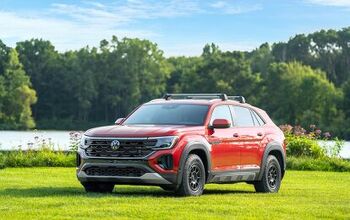Piston Slap: A Fresh Look at Brand Extensions. Seriously.

John writes:
What do we know about the 1.8L V6 used in the 1990s’ Mazda MX-3 sport coupe? Why such a small engine and where did Mazda get it from/how did they design it and market it in the MX-3?
Sajeev answers:
Piston Slap is not merely a mechanical question/answer series, because any automotive question you’d see on a car forum is fair game. And with that, Mazda’s MX-3: a 2+2 coupe based on sedan chassis, a trick rear suspension, ABS brakes and an 1.8L V6 as an option. The MX-3 offered a more refined style and powertrain goodness to the basic theme of the 1980’s hot hatchbacks: think about the latest BMW 5-series GT crossover versus the relatively crude X5 brother, circa 1999.
I drove one of Mazda’s micro-sized V6’s and it certainly was a sweetheart: a Grand Tourer in the microcar tradition, perhaps? The MX-3 was a good car, but it’ll never get the recognition of its hot-hatch forefathers and sport compact contemporaries. And that shows how car makers over-extend an engine family just like a chassis (GM’s W-body) or a brand (Lincoln Zephyr or Acura RL). And that’s a deadly sin worthy of Paul Niedermeyer’s consideration.
More to the point, the MX-3’s wee-little V6 motor is based on Mazda’s K engine family which offered surprising refinement and impressive torque for a low cost vehicle, especially considering the soft-on-the-bottom four cylinders from other Japanese manufacturers. An enlarged version (2.5L) found its way into the midsized Mazda MX-6 and Ford Probe sport coupes while the supercharged, Miller Cycle V6 in the Mazda Millenia aimed at the near luxury market. Too bad the pricey Millenia was no BMW, and the MX-3 couldn’t go nearly as fast and furious as the Integra.
It’s a shame that this motor didn’t fare better in sales and performance, but I wouldn’t be surprised if Ford’s Duratec V6 adopted many of its design hallmarks. Partly because Ford refused to learn from Mazda’s mistakes: the 3.0L Jaguar X-type was a half-assed tribute to the force-fed Millenia, and the 2.5L Mercury Cougar hatchback took everything right with the MX-3 and still failed miserably. So yes, even greasy bits underhood are designed with corporate-level branding problems in mind, and sometimes pay the price for their ignorance.
(Send your queries to mehta@ttac.com)

More by Sajeev Mehta
Latest Car Reviews
Read moreLatest Product Reviews
Read moreRecent Comments
- ToolGuy 9 miles a day for 20 years. You didn't drive it, why should I? 😉
- Brian Uchida Laguna Seca, corkscrew, (drying track off in rental car prior to Superbike test session), at speed - turn 9 big Willow Springs racing a motorcycle,- at greater speed (but riding shotgun) - The Carrousel at Sears Point in a 1981 PA9 Osella 2 litre FIA racer with Eddie Lawson at the wheel! (apologies for not being brief!)
- Mister It wasn't helped any by the horrible fuel economy for what it was... something like 22mpg city, iirc.
- Lorenzo I shop for all-season tires that have good wet and dry pavement grip and use them year-round. Nothing works on black ice, and I stopped driving in snow long ago - I'll wait until the streets and highways are plowed, when all-seasons are good enough. After all, I don't live in Canada or deep in the snow zone.
- FormerFF I’m in Atlanta. The summers go on in April and come off in October. I have a Cayman that stays on summer tires year round and gets driven on winter days when the temperature gets above 45 F and it’s dry, which is usually at least once a week.
































Comments
Join the conversation
Daewoo had System Porsche develop an inline six in 2.0 and 2.5 litres for transverse front wheel drive applications in about 2002, and this engine was actually sold in a US market Suzuki badged vehicle for awhile, as well as Canadian market Chevrolet Epica cars, I believe they were badged. GMDaewoo never referred to the engine as having been developed by System Porsche, either there must have been some alterations to it before production or GM simply didn't wish to publicize another company's name. Back in the 1980's, System Porsche (not related to the Porsche auto company, but an engineering consulting company) also developed the Heron head inline four cylinder engines and manual transaxles for the SEAT Malaga and Ibiza ranges, which were based upon altered FIAT bodyshells at the time. Then VW bought SEAT and broomed out the "consultant engineered" engines in lieu of VW types.
The issue with MX-3 was tough competition in its price range. Though they never seemed to rule spec sheet wars in the US, the K series engines are great engines. Sure other engines made more power but those motors were smooth and sounded awesome. Most of my experience was with the 2.5 in the ProbeGT. I could have gone faster in , but those K motors are the kind of engines where you turn the radio off and find a tunnel to drive through. The 2.5 - 3.0 duratecs are horrid in comparison to the k series in terms of refinement. Running the K's up to redline was smooth and rewarding. Duratecs....not so much.